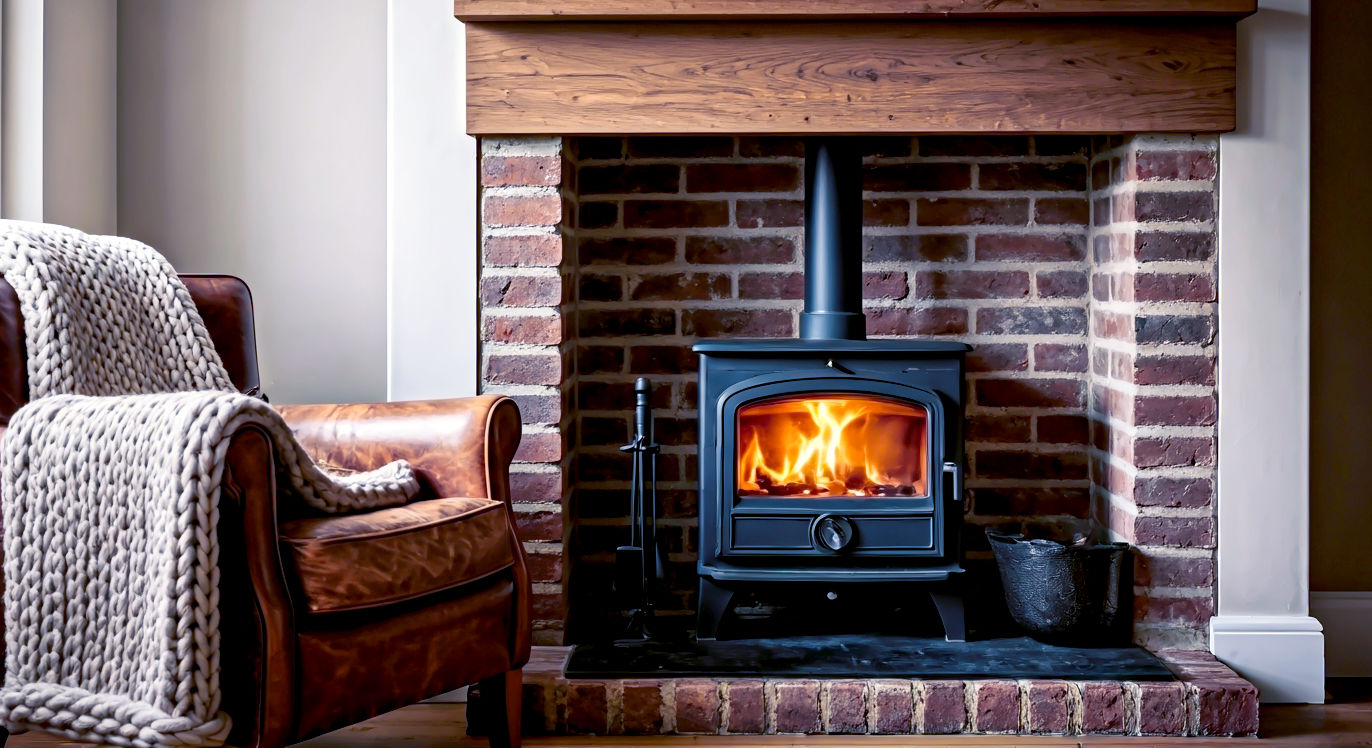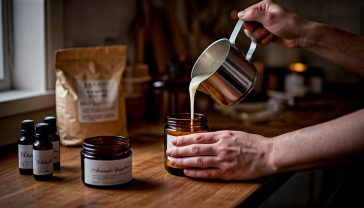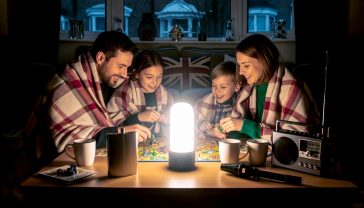The Fireplace Guide: Types, Designs & Inspiration for the British Home
The ultimate British guide to fireplaces. Discover different fuel types, design inspiration for every home, and essential UK installation regulations.

This post may contain affiliate links. If you make a purchase through these links, we may earn a commission at no additional cost to you.
There’s something almost magical about a fireplace, isn’t there? It’s more than just a way to heat a room; it’s the heart of the home. Think of those chilly, damp evenings when the wind is howling outside. A crackling fire doesn’t just warm your hands; it warms your soul. For centuries, British homes have been built around the hearth. It’s where families have gathered, stories have been told, and countless cups of tea have been enjoyed. It’s a symbol of comfort, security, and that special feeling the Danes call hygge—a sense of cosiness and contentment.
But choosing a fireplace today is a bit more complicated than it was in our grandparents’ time. You’ve got to think about fuel types, efficiency, clean air rules, and a dizzying array of designs. Do you want the rustic charm of a real wood-burner or the sleek convenience of a modern gas fire? Should you restore that beautiful old Victorian fireplace or go for something completely new?
Don’t worry. This guide is here to walk you through everything you need to know. We’ll break down the different types of fireplaces, explore stunning design ideas, and give you the practical advice you need to make the perfect choice for your home. So, pull up a comfy chair, grab a biscuit (or two), and let’s get started.
Part 1: Understanding the Basics – How Fireplaces Work
Before we get into the exciting world of designs and styles, it’s helpful to understand the basic bits and bobs that make a fireplace work. It’s a bit like knowing what’s under the bonnet of a car. You don’t need to be a mechanic, but it helps to know what the key parts do.
At its simplest, a fireplace is a safe, contained space to have a fire indoors. The whole setup is designed to do two main things: provide heat to your room and get rid of the smoke and harmful gases safely up the chimney.
The Key Components of a Fireplace
Let’s look at the main parts you’ll find in a traditional fireplace and chimney system.
- Hearth: This is the floor of the fireplace. It’s made of a fireproof material like stone, slate, or brick. It also extends out into the room to protect your flooring from stray sparks and embers. Think of it as a protective welcome mat for your fire.
- Firebox (or Fire Chamber): This is the main box where you actually build the fire. It’s built to withstand incredibly high temperatures. The sides are often angled to help push more heat out into the room.
- Surround (or Mantelpiece): This is the decorative frame around the fireplace opening. It can be made from wood, stone, marble, or cast iron and it’s the part that really defines the style of your fireplace. It’s the ‘picture frame’ for your fire.
- Chimney Breast: This is the part of the wall that juts out into the room to house the fireplace and the flue.
- Throat: Just above the firebox, there’s a narrow opening called the throat. It’s cleverly designed to help funnel the smoke and gases up into the flue.
- Damper: Many older fireplaces have a damper, which is a metal plate in the throat or flue that you can open and close. When the fireplace isn’t in use, you close it to stop drafts coming down the chimney.
- Flue: This is the crucial bit—it’s the pipe or channel that carries the smoke and gases from the fire all the way up and out of your house. It’s the fireplace’s exhaust pipe.
- Flue Liner: Modern chimneys have a flue liner. This is a tube (often made of stainless steel or clay) that sits inside the chimney structure. It’s a massive safety feature. It protects the chimney’s stonework from heat and corrosion, prevents fumes from leaking into your home, and helps the fire burn more efficiently.
- Chimney Stack & Pot: The chimney stack is the part of the chimney you see sticking out of the roof, and the chimney pot is the clay pot on top. It helps increase the draft and stops rain from getting in.
The magic that makes it all work is the draft (or draught, as we often spell it). Hot air rises, right? Well, the hot gases from your fire are much lighter than the cooler air in your room. This difference creates a kind of suction, pulling the smoke up the flue and drawing fresh air (oxygen) into the firebox to keep the fire burning. A good draft is the secret to a happy, smoke-free fireplace.
Part 2: The Great Fuel Debate – Wood, Gas, Electric, or Multi-Fuel?
One of the biggest decisions you’ll make is what you want to burn. Each fuel type has its own pros and cons, from the authentic crackle of real wood to the instant, no-mess heat of electricity.
Wood-Burning Fireplaces & Stoves
There’s nothing quite like the smell, sound, and look of a real wood fire. It’s the classic, romantic choice.
- How they work: You burn seasoned logs in a firebox or a highly efficient wood-burning stove. A stove is a metal box that gets much hotter than an open fire, meaning it burns the wood more completely and throws out a lot more heat.
- The Good Bits:
- Unbeatable Atmosphere: The crackle, the glow, the smell—it’s the real deal.
- Renewable Fuel: If you use wood from sustainably managed forests (look for the FSC logo), it’s a carbon-neutral fuel source. The carbon dioxide released when you burn it is offset by the carbon the tree absorbed while it was growing.
- Lower Running Costs: If you can source wood cheaply or for free, it can be a very cost-effective way to heat your home.
- The Not-So-Good Bits:
- Effort Required: You need to buy, transport, stack, and store logs. You also need to clean out the ash regularly.
- Slower to Heat Up: It takes time to get a good fire going.
- Smoke Control Areas: Many parts of the UK are Smoke Control Areas. This means you can’t just burn any old wood on an open fire. You either have to use a DEFRA-exempt appliance (a very clean-burning stove) or burn authorised smokeless fuels. You can check your postcode on your local council’s website.
Top Tip: Always burn seasoned or kiln-dried hardwood with a moisture content below 20%. Wet wood is a nightmare—it’s hard to light, produces lots of smoke and tar (which can damage your flue), and gives off very little heat.
Multi-Fuel Stoves
A multi-fuel stove gives you the best of both worlds. It looks just like a wood-burning stove but has a clever grate that lets you burn either wood or smokeless mineral fuels.
- How they work: They have a raised grate with moving bars (a riddling grate) that allows air to get underneath the fuel, which is essential for burning coal or other smokeless fuels effectively. Wood, on the other hand, burns best on a flat bed of ash.
- The Good Bits:
- Fuel Flexibility: You can switch between wood and smokeless fuels depending on price and availability.
- Longer Burn Times: Smokeless fuels can often smoulder away overnight, keeping the room gently heated.
- High Efficiency: Just like wood-burners, modern multi-fuel stoves are incredibly efficient.
- The Not-So-Good Bits:
- Slightly Less Efficient for Wood: Because of the grate design, they aren’t quite as efficient at burning wood as a dedicated wood-burner, but the difference is small.
- Still Needs Cleaning: You’ll still be dealing with ash, though often less than with just wood.
Gas Fireplaces
For those who love the look of a real flame but want instant heat and zero mess, a gas fireplace is a brilliant option.
- How they work: They burn natural gas or LPG and are controlled with a switch, a remote control, or even a smartphone app. They have realistic-looking ceramic logs or coals that glow just like a real fire.
- The Good Bits:
- Ultimate Convenience: Instant heat at the touch of a button. No mess, no fuss, no cleaning.
- High Efficiency: Modern glass-fronted gas fires can be over 90% efficient, meaning almost all the heat comes into your room.
- Controllable: You can easily adjust the flame height and heat output.
- The Not-So-Good Bits:
- Lacks Real-Fire Charm: You don’t get the crackle or the smell of a wood fire.
- Installation Costs: Can be more expensive to install, especially if you need a new gas line.
- Running Costs: Can be more expensive to run than a wood-burner, depending on gas prices.
Important Note: Gas fires need to be installed and serviced annually by a Gas Safe registered engineer. It’s the law, and it’s vital for your safety.
Electric Fireplaces
Electric fires have come a long, long way from the old-fashioned ones with glowing orange bars. Modern versions use incredible LED technology to create stunningly realistic flame effects.
- How they work: They are essentially a stylish electric heater with a visual display. You just plug them into a standard socket.
- The Good Bits:
- Install Anywhere: No chimney or flue needed! You can put one in any room, even in a flat.
- 100% Efficient: All the electricity used is converted into heat.
- Flame-Effect Only: You can enjoy the cosy flame effect even in summer without the heater on.
- Zero Mess or Maintenance: No cleaning, no servicing.
- The Not-So-Good Bits:
- The Flame Isn’t Real: While the effects are good, you know it’s not a real flame.
- Running Costs: Electricity is generally the most expensive way to heat a room per kilowatt-hour.
- Limited Heat Output: They are great for taking the chill off a room but usually can’t replace your central heating.
Part 3: Design & Inspiration – Finding Your Perfect Fireplace Style
Now for the fun part! The fireplace is the focal point of a room, and its style can transform the entire space. Whether you live in a grand Georgian townhouse, a cosy country cottage, or a minimalist modern flat, there’s a fireplace for you.
Traditional & Period Styles
Restoring or recreating a period fireplace can add incredible character and value to your home.
- Victorian (1837-1901): The Victorians loved ornamentation. Their fireplaces were typically made of cast iron, often with intricate designs of flowers, birds, and patterns, surrounded by beautifully decorated tiles. A grand marble or slate mantelpiece would often complete the look. These are perfect for adding a touch of grandeur to living rooms and bedrooms in period properties.
- Georgian (1714-1830): Georgian design was all about elegance, symmetry, and classical proportions. Fireplace surrounds were often made of stone or wood and were less fussy than Victorian ones, featuring simple, clean lines, columns, and classical motifs like urns and swags. Think of the beautiful, understated fireplaces in a Jane Austen novel.
- Edwardian (1901-1910): Edwardian style was lighter and simpler than Victorian. It took inspiration from the Arts and Crafts movement, featuring simpler shapes, taller openings, and often plain, elegant wooden surrounds.
- Art Deco (1920s-1930s): For a touch of Jazz Age glamour, look no further than Art Deco. These fireplaces are characterised by bold, geometric shapes, stepped designs, and often feature beautiful tiled surrounds in shades of cream, green, or black.
Rustic & Country Styles
If you’re aiming for a cosy, country-kitchen feel, these styles are for you.
- The Inglenook: This is the classic country fireplace—a large opening, often with a huge oak or stone beam (a bressummer) above it and space for a couple of chairs inside. Originally designed for cooking, today they make a spectacular home for a large wood-burning stove.
- Brick & Stone: A simple, exposed brick or stone fireplace creates a wonderfully warm and rustic feel. It’s an honest, unpretentious style that works brilliantly in cottages, farmhouses, and barn conversions.
- Limestone & Sandstone: These natural stones have a softer, warmer look than marble or granite. A simple, chunky limestone surround brings a touch of rustic French or Cotswold charm to a room.
Modern & Contemporary Styles
Modern fireplaces are all about clean lines, minimalism, and innovative design.
- Hole-in-the-Wall: This is a super-sleek, minimalist option. The fire (usually gas or electric) is set directly into the wall with no hearth or surround, creating a clean, uncluttered look. It’s perfect for modern living spaces where you want the fire to be a feature, but not an overpowering one.
- Two-Sided & Three-Sided: These stunning fireplaces can be built into a dividing wall, allowing you to see the flames from two or even three different rooms. They make a real architectural statement and are great for open-plan living.
- Freestanding Stoves: A contemporary stove can be a piece of sculpture in its own right. Many modern stoves from Scandinavian and European designers are sleek, cylindrical, or even hang from the ceiling. They make a bold statement and are incredibly efficient.
- Media Walls: A very popular trend is the media wall, where a long, letterbox-style electric or gas fire is installed below a large, wall-mounted television. It creates a fantastic, all-in-one entertainment hub and focal point for the living room.
Part 4: The Practical Stuff – Installation, Regulations & Maintenance
Choosing your fireplace is one thing; getting it installed safely and legally is another. This is one job where you absolutely should not cut corners.
Chimneys and Flues
- Existing Chimneys: If you have an existing chimney, it must be swept and inspected by a professional before you install a new fireplace or stove. They will check for blockages (like old birds’ nests) and carry out a smoke test to make sure it isn’t leaking. Most older chimneys will need to be fitted with a flue liner.
- No Chimney? No Problem!: If you don’t have a chimney, you can still have a wood, multi-fuel, or gas fire. You can install a twin-wall flue system. This is a pre-fabricated, insulated metal flue that can run up an outside wall or through the house. For a gas fire, you can often use a balanced flue, which is a pipe that goes directly through an external wall. And of course, electric fires need no flue at all.
Key Regulations to Know
In the UK, installing a solid fuel appliance (like a wood-burner) is considered ‘controlled work’, so it has to be signed off to make sure it complies with Building Regulations.
- HETAS: The simplest way to do this is to use an installer registered with HETAS (Heating Equipment Testing and Approval Scheme). They are trained and assessed to be competent and can self-certify their work. They will give you a certificate of compliance, which you’ll need if you ever sell your house. If you don’t use a HETAS installer, you’ll have to apply to your local council’s Building Control department for approval, which is more hassle and costs more.
- Gas Safe Register: As mentioned earlier, all gas fireplaces must be installed by a Gas Safe registered engineer.
- Hearths & Clearances: Building Regulations are very strict about the size of the hearth and the distance that combustible materials (like wooden beams, wallpaper, and furniture) must be from the fireplace or stove. Your installer will ensure all these rules are followed.
- Ventilation: All fires need oxygen to burn. If your stove has a heat output of more than 5kW, you will probably need to have an air vent fitted in the room to ensure a good supply of fresh air. This is vital to prevent the build-up of dangerous carbon monoxide.
Don’t Forget the Carbon Monoxide Alarm!
This is a legal requirement. If you are having a new solid fuel or gas appliance installed, you must have a carbon monoxide (CO) alarm fitted in the same room. CO is a silent, odourless killer, and an alarm is a cheap and simple lifesaver.
Ongoing Maintenance
To keep your fireplace safe and efficient, a little bit of TLC is required.
- Get Your Chimney Swept: This is the most important job. You should have your chimney swept at least once a year if you’re burning smokeless fuels, and twice a year if you’re burning wood. A professional sweep will remove soot and tar (creosote), which can cause chimney fires.
- Clean the Stove/Fireplace: Regularly empty the ash and clean the glass on your stove door. Special stove glass cleaner works wonders!
- Check Rope Seals: The rope seals around the stove door need to be checked annually to make sure they are creating a good airtight seal.
- Service Gas Fires: Get your gas fire serviced every year by a Gas Safe engineer.
Part 5: Looking to the Future – Eco-Design and Beyond
As we all become more environmentally conscious, the fireplace industry is changing too. The days of smoky, inefficient open fires are numbered.
The big news is the Eco-design 2022 regulation. This EU rule, which the UK has kept after Brexit, sets strict new minimum efficiency levels and maximum emission limits for all solid fuel stoves. Any stove manufactured and sold today must be Eco-design ready.
These new stoves are amazing pieces of engineering. They are designed to burn fuel so efficiently that they produce around 80% fewer emissions than a stove made 10 years ago and 90% fewer than a traditional open fire. They are better for air quality and better for your wallet because you get so much more heat from every log you burn.
So, when you’re shopping for a new stove, make sure it’s Eco-design Ready. It’s the responsible choice and ensures your fireplace is fit for the future.
The Enduring Appeal of the Hearth
Fireplaces have been at the centre of our homes for thousands of years. They have evolved from a simple necessity for warmth and cooking into a powerful symbol of comfort, family, and home.
Whether you choose the timeless appeal of a crackling log fire in a grand Victorian surround, the rustic charm of a stove in an old inglenook, or the sleek, minimalist beauty of a modern hole-in-the-wall gas fire, you are tapping into that ancient, deep-seated human love for the hearth.
Choosing a fireplace is a big decision, but it’s also an incredibly exciting one. It’s a chance to add real warmth, character, and soul to your home. We hope this guide has given you the confidence and inspiration to find the perfect fireplace to create your own cosy corner of the world.
Further Reading
For more detailed information, regulations, and to find certified professionals, please visit these highly respected resources:
- HETAS: The official body for solid fuel domestic heating appliances, fuels, and services. https://www.hetas.co.uk/
- Gas Safe Register: The official list of gas engineers who are qualified to work safely and legally on gas appliances. https://www.gassaferegister.co.uk/
- Solid Fuel Association: The official body advising on the use of solid fuels. https://solidfuel.co.uk/
- DEFRA (Department for Environment, Food & Rural Affairs): For information on Smoke Control Areas. https://www.gov.uk/smoke-control-area-rules
- The Period Property Owners’ Club: A fantastic resource for advice on period fireplaces. https://www.periodproperty.co.uk/






